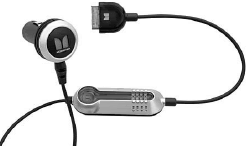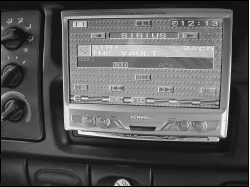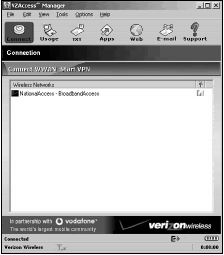Your car is the ultimate mobile device; it is also probably the most complex computer you own. The automotive industry is the largest consumer of embedded processors in the world.
In an age of convergence, it is not surprising that manufacturers are marrying one technology, the automobile, with another, wireless networking. We are just at the beginning of this trend, but already the range of services is extraordinary.
With a satellite-guided GPS system, you need never be lost again, and the necessary directions to your next destination is only a few buttons away. In place of AM/FM radio you now can choose satellite radio, which will narrowcast your favorite content in a way that only a premium service can.
You can buy devices to broadcast your iPod’s MP3s over your car’s sound system, FM radio, and much more. The automobile is a great platform for wireless computing because it is a controlled environment in a small space.
Devices can be low powered, local, and controlled. One day you may see Bluetoothenabled cars that provide a cushioning bubble around the car that prevents collisions, help you park, or communicate with sensors in the roadbed to help traffic planners route traffic efficiently.
For now we have devices such as FastLane, which puts a transponder in your car that enables you to drive through a toll booth on the Massachusetts turnpike, or one in New York, New Jersey, or elsewhere and have the charges automatically billed to your account.
Internet
The idea of having Internet access in your car isn’t new, but it is an idea whose time is coming, if it isn’t here already. If you purchased a Mercedes-Benz starting in 2001 you could get an integrated cell phone in their COMMAND console.
That console displays text with information from the Internet, displayed in the way that many cell phones with small screens do. By 2003, vendors were introducing systems that provided Internet access directly for any device you wanted to connect to it.
For example, one company called IP Wireless demonstrated a wireless modem with speeds of 400 Kbps, with 3 Mbps promised. The beauty of the device is that it’s entirely portable and can work wherever a cell phone works.
IP Wireless used the CDMA cell phone standard, but boosted data throughput by synchronizing the different data streams and collecting them into contiguous packets. The system was put into demonstration that year, but awaits implementation from cellular providers.
IP Wireless’s system brings us to the most important point about Internet in your car—it is most likely to be a cellular technology that connects you to the Internet, and your mobile phone company is the most likely provider.
As phone companies introduce third-generation wireless networks, the so-called 3G networks, the switch from connected PDAs to connected laptops is just around the corner. You can get access today from a number of companies through their cellular networks, but Verizon Wireless’s entry in this category is a good example.
With its NationalAccess plan and system you can connect from a data-enabled smart phone, or from a laptop with a PC Card to a VPN at a current rate of 40 to 50 Kbps average with bursts up to 144 Kbps.
The cards currently recommended by Verizon Wireless for this system are the AirPrime PC 3220 Card, the Audiovox PC 5220, and the Sierra Wireless AirCard 580 PC type II PC card shown in Figure below.
These cards operate on the IS-95 networks that work with a dial-up connection over a cellular network. Needless to say, because this system works with a cell phone in your car, it also works connecting your laptop to the same network.
Figure below shows the VZAccess Manager software that you download from Verizon Wireless’s Web site to install on a Windows PC. This is a connection manager and a dialer that helps you manage your NationalAccess sessions.
Microsoft’s Windows CE for Automotive, an initiative based on its .NET architecture, illustrates the potential uses of Internet technology for an automobile.
Although your car already has sensors in it that report conditions to a car computer, manufacturers have yet to connect those computers to a central computer over the Internet.
Doing so would allow the manufacturer to measure not only the time to replace fluids or perform a maintenance of some kind, but to consider your driving habits based on actual data and recommend specific settings and adjustments.
What Microsoft calls the “Connected Car” would offer a range of services including safety systems, routing, entertainment, diagnostics and monitoring, theft prevention, and computer access to the Internet. What Microsoft is providing developers is a Windows Automotive platform that will contain features such as:
- Speech and speech recognition.
- Hands-free communication.
- Audio/Video.
- Mapping and graphics.
- Support for the wireless technologies of 802.11.
- Bluetooth.
- CDMA (Code Division Multiple Access—a cell phone protocol).
- And General Packet Radio Service (GPRS).
MP3 Players
You know the drill. You’ve got your musical life all ripped onto your MP3 player and now you want, no, you need to hear those great songs of yesteryear playing on your car’s sound system as you lay rubber to the road and cut the night with your beams.
If you haven’t been so fortunate as to buy a new, expensive car with an MP3 playback capability, relax. Adding a wireless connection from your MP3 player (or any audio device) is one of the easiest things you can do. That’s the hook used for the commercials offering iPods along with white Volkswagen Beetles.
Figure below shows the Monster Power iCarPlay Wireless – FM Transmitter for iPods.
 A number of vendors sell an FM radio car stereo transmitter that plugs into your device’s audio or headphone output jacks and transmits a signal that your radio can tune into.
A number of vendors sell an FM radio car stereo transmitter that plugs into your device’s audio or headphone output jacks and transmits a signal that your radio can tune into.
The sending device can be any portable sound source, a DVD player for the kiddies in the back, your laptop, and others.
You can adjust the frequency of the transmission to get the best sound from one of several, which in most cases gives really excellent results, the equal of any commercial FM station on your radio at its best.
Radio Shack’s model offers four frequencies, 100 hours battery lifetime, a 10- to 30-foot range, with a rated response of from 50 to 15 KHz with 45dB stereo separation and 0.5 signal distortions.
That’s near high fidelity, and about as good as you can do with almost any in-car stereo system. You’ll find similar units from Monster Cable, Belkin, RCA, and others.
GPS
As you probably know already, the Global Positioning System (GPS) is a satellite-based radio transmission system for locating any position on earth based on triangulation data obtained from three to eight satellites.
With multiple measurements, GPS can calculate speed and direction as well as store the path you used to get to where you are so that you can make a return trip. The system was launched for the U.S. military, and is still used for that purpose.
GPS is a very sophisticated system, and can locate objects to within a few feet of their position. In the past the system was detuned so that precise location couldn’t be determined to any better than 35 feet, but that restriction was lifted and now you can get positioning accurate to within 10 feet.
A technology that gives you position and directions is a nearly perfect application for mobile devices. We first encountered GPS in a Hertz car rental when we used its NeverLost system.
NeverLost uses a Windows CE device running Magellan software to store and process a database that contains location and mapping, points of interest, businesses, restaurants, hotels, parks, city halls, and a host of other things.
As you travel, NeverLost speaks to you, telling you when to turn, how far to go, and in what direction. In the days when GPS was detuned, the NeverLost system retuned the device by using a gyroscope to measure the direction of movement and the miles traveled to extrapolate your current position from your last triangulated one.
Thus you could go through a long tunnel and still be relatively accurately positioned when you emerged. NeverLost was and is remarkable, but more remarkable still is how low the prices and how much greater the capabilities of GPS devices are today.
You can very easily add GPS to any car by buying a GPS device from one of several different companies, such as Garmin, NAVMAN, and Magellan. These devices can be portable and are meant not only for cars but for backpacking as well. Devices run from around $150 to $2,000. What do you get for more money?
How about 10-foot accuracy, multiple routes, hundreds of waypoints and track points, detailed color maps, locations of gas stations, rest areas, restaurants; data on the moon, sunrise and sunset; and up-to-date construction information. The highest-end systems offer instructions given to you by voice.
Adding GPS to a laptop is equally easy. If you have purchased a mapping program such as Microsoft Streets and Trips, Rand McNally’s StreetFinder, or Delorme Street Atlas USA, you may have noticed that these packages can read the signals from GPS position locators.
You can also find ample shareware and freeware in this category. A search on Download.com for the word “GPS” returns 37 listings. For the most part, adding a GPS device to your laptop is as simple as installing the necessary drivers and plugging the device into your computer.
Most GPS devices are USB connected, although earlier models were more often serial port devices. You’ll probably find that the GPS device you purchase comes with one of the software packages mentioned above.
When buying devices like these, try to make sure that they conform to the marine standard so that they are broadly compatible. GPS is more than just a simple convenience; it offers us the potential for great efficiencies, and can and does save lives every day.
You’ll find GPS on your PDA, in your cell phone, on your laptop, in your car, in watches, and on handheld devices—just about anything that moves. Every year the technology gets cheaper and one day it will be ubiquitous, a true commodity.
Satellite Radio
Wireless entertainment has proven to be a vibrant new area of technology for automobiles, and its introduction, while not overwhelming, looks like it can capture enough market share to be a viable product niche.
The best example of wireless technology in the automobile so far has been satellite radio. To receive satellite radio, you need a special receiver that can capture SIRIUS, WorldSpace, or XM Radio, which are the three market leaders.
Although the initial systems in the market were pricey, newer models have come in at price points under $100, which makes them more affordable to the average person and suitable for portable music devices.
Each of these services requires a monthly subscription fee that averages about $10 to $12 a month. What makes satellite radio, sometimes called digital radio, attractive to users is that it offers many stations, some with very specific content (narrowcasting), a high-quality sound, and is mostly commercial free.
Whereas FM radio has a range of around 40 to 50 miles, the signal can be heard outside that range only when the signal goes through a repeater station. By contrast, a satellite signal can travel uninterrupted from far away in space, even halfway around the world.
The net result is that you could travel vast distances and stay connected without interruption and at the same high quality level. Both XM Satellite Radio and SIRUIS Satellite Radio specifically target the automobile market, and their receivers started to be offered in cars in 2001.
Satellite radio is available by direct reception on your receiver. In some areas of coverage satellite signals compete with many other similar signals. Satellite radio uses ground repeaters to extend the radio signal in dense urban reception areas in particular.
Although the signal has wide coverage, it isn’t a universal signal like GPS, which you can get anywhere in the world. You need to be in range of the satellite or one of the repeaters with your special receiver to make satellite radio work. The satellite radio system uses a band around 2.3 GHz, also called the “S” band.
That band is very close to the 802.11g band at 2.4 GHz. The satellite radio band was created by the FCC (Federal Communications Commission) in 1992 and two companies were licensed for broadcast: CD Radio (now SIRIUS) and American Mobile Radio (now XM).
It’s taken a while, but XM launched on September 25, 2001 and SIRIUS launched on July 1, 2002. Outside the United States a company called WorldSpace broadcasts in Africa, Asia, and South America.
The satellites being used by each company are different. XM Radio has two satellites in geostationary orbit, affectionately dubbed “Rock” and “Roll.” General Motors and Honda are both investors in XM Radio, and have made big commitments to install their receivers in the cars they make.
Alpine, Clarion, Delco, Motorola, and Sony, among others, make receivers for XM Radio, that offer 100 plus channels commercial-free as a subscription service. The SIRIUS service uses three satellites in an elliptical orbit.
The system has a satellite over the U.S. during all hours, with each satellite being in range 16 out of 24 hours a day. SIRIUS receivers can be converted to a lower frequency and with an adapter can play over a standard AM/FM car radio.
That lets you add SIRIUS to your current automobile without having to replace your current sound system. XM Radio offers a similar add-on device. Figure below shows the Kenwood KVT-M700 in-dash TV-style receiver with motorized touch-sensitive screen set in a dashboard console.
 The company with the largest installed base in digital satellite radio is actually WorldSpace. It has three geostationary satellites: AfiStar for Africa, AsiaStar for Asia, and AmeriStar for South America and southern Central America.
The company with the largest installed base in digital satellite radio is actually WorldSpace. It has three geostationary satellites: AfiStar for Africa, AsiaStar for Asia, and AmeriStar for South America and southern Central America.
Its satellites went up between 1998 and 2000 and each carries 40 to 50 radio channels at the moment. Unlike XM and SIRIUS, WorldSpace uses the 1.4 MHz part of the L-Band, another area that has been designated for use by the digital broadcast industry.

